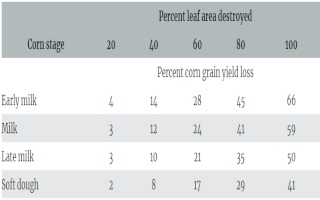Corn
When assessing the impacts of storm damage on corn, it is helpful to know the crop stage at the time of damage. Corn that was damaged by the recent storms was in the late milk to early dough kernel stages. When corn faces drought or other stressors, kernels can dry out and be lost up through the end of the milk stage. Once corn enters the dough stage, kernels can no longer be lost due to drought or other stressors. Older corn would have also had larger kernels than younger corn at the time of damage. Therefore, corn that was younger at the time of damage is likely to experience greater yield loss, since the two primary yield components are the number of kernels per acre and the size of the kernels.
Once corn has tasseled, all leaves on the plants have emerged and there are no new leaves that can emerge to compensate for leaf area that was lost due to hail damage. Leaf loss reduces the amount of leaf area available for capturing sunlight, and therefore subsequently reduces the amount of sugars produced by photosynthesis that are available for being translocated to the developing ear. Therefore, corn yield loss due to hail damage is closely related to the amount of remaining leaf area. The reduction in corn grain yield due to leaf loss at various growth stages is shown in Table 1.

In addition to leaf loss, storm damage to corn can also cause root lodging, stalk breakage, stalk bruising, and ear damage. This makes it difficult to accurately predict yield loss prior to harvest.
Root lodging
When soils are saturated, strong winds can cause corn plants to lean over due to pulling of shallow roots. Within a few days, root-lodged plants typically straighten, and stalks have a curved appearance. Yield loss due to root lodging is greater when the crop is more mature at the time of root lodging. Little information is available on the severity of root lodging after tasseling, but a study in Wisconsin found that root lodging to corn a few days before tasseling reduced grain yield by 30% (Carter and Hudelson, 1988, Journal of Production Agriculture). Corn that has experienced root lodging after tasseling can be very challenging to harvest, and it is important for combine operators to monitor harvest losses and adjust accordingly. Combine operators may need to slow the speed of travel, make adjustments to the header, harvest in a single direction, or mount specialized reels or sweepers onto the corn head in order to harvest down corn.
Stalk breakage and bruising
Stalk breakage from hail or wind reduces the amount of leaf area, and if it occurs below the ear it also reduces the number of harvestable ears per acre and has a greater impact on yield. Corn plants that are adjacent to stalk-broken plants can partially compensate for the damaged plants by producing slightly larger ears due to a greater amount of sunlight available, but the level of compensation will be relatively small. The younger the corn is at the time of damage, the greater the potential for undamaged plants to compensate for damaged plants that are adjacent to them.
Bruising of stalks by hail limits the plant's ability to translocate water and nutrients, and it also reduces standability. Plants with stalk bruising should have their stalks split to determine the severity of the bruising. Plants with damage extending beyond the rind of the stalk and into the pith either will not recover or will have large reductions in yield. Fields with severe stalk bruising should be harvested early to avoid significant harvest losses from stalk lodging.
Damaged ears
Ears that are damaged by hail stones can lose kernels in the damaged areas. Damaged ears are also at elevated risk for developing ear rots and mycotoxins. Some growers may choose to harvest a damaged corn crop as silage rather than grain. One can expect reduced feed quality for corn silage that is damaged by hail, in part due to a reduction in grain. Hail-damaged silage may also have higher-than-expected harvest moisture which can affect storage, and it should be checked for mycotoxins and nitrate levels. High nitrate levels can occur in corn silage when the grain-to-stover ratio is reduced due to drought or ear/kernel loss. Raising the cutter bar to a height of 10 to 12 inches avoids harvesting the lowest part of the stalk, which has the highest concentration of nitrates. Feed managers may choose to dilute hail-damaged silage with other feedstuffs of higher quality before feeding to livestock.
Source : umn.edu